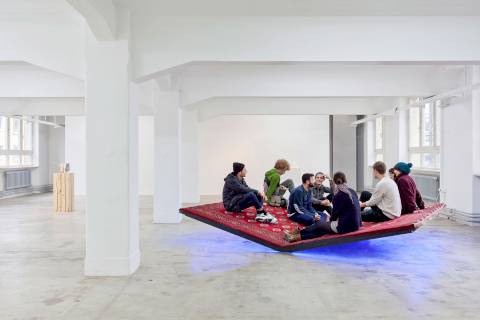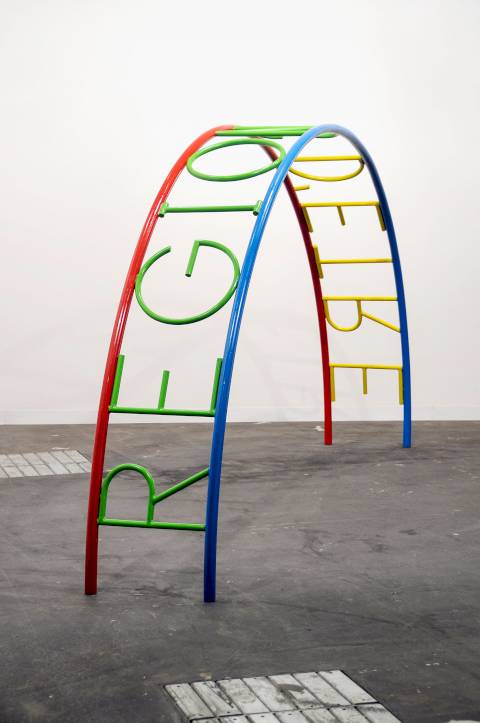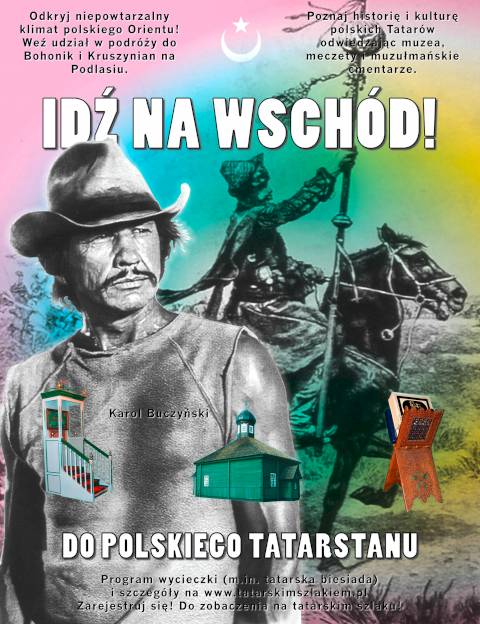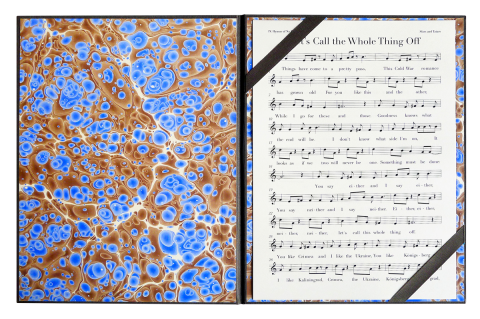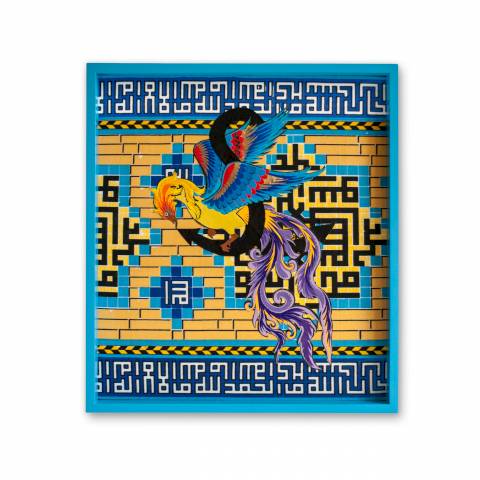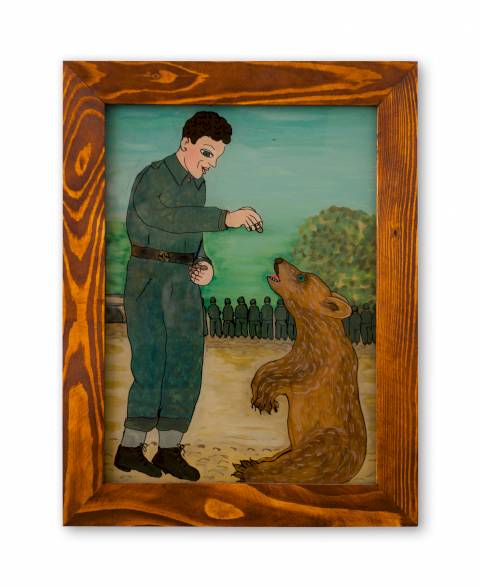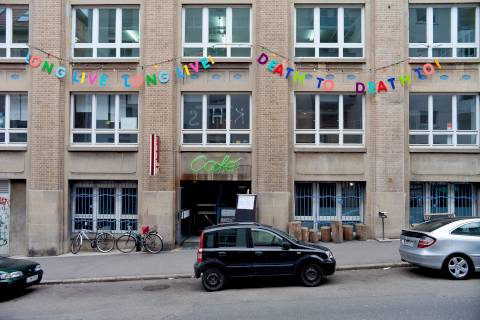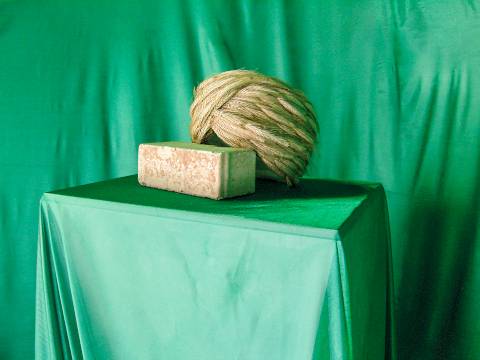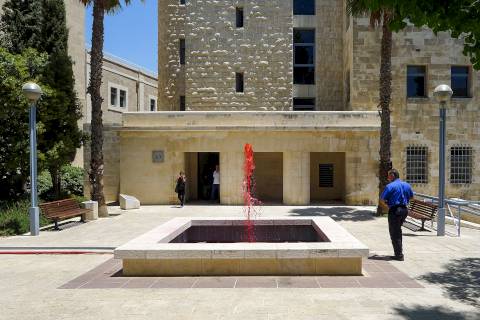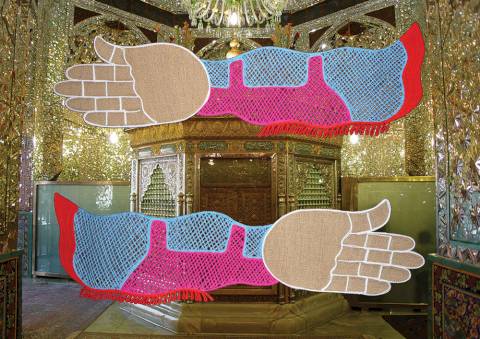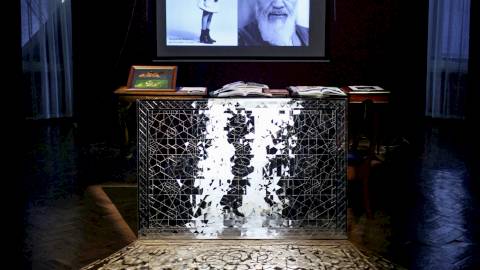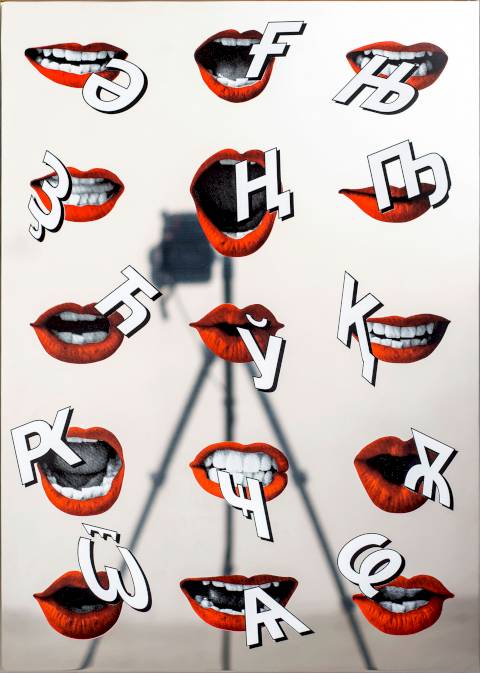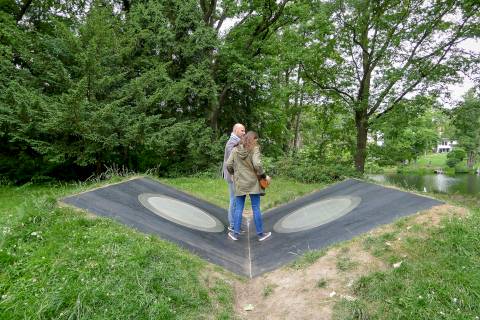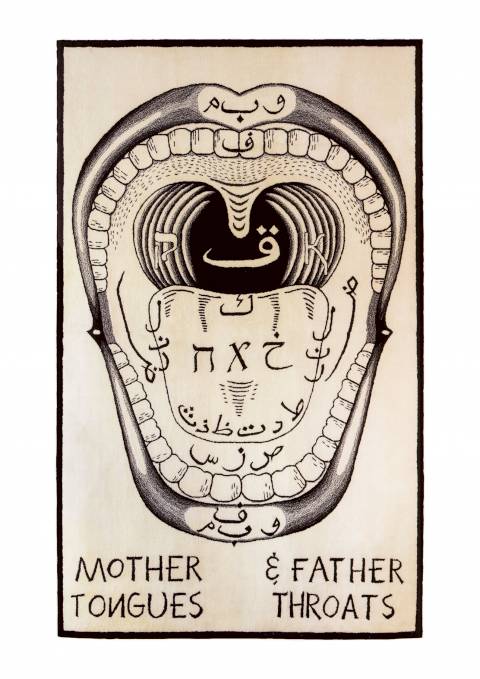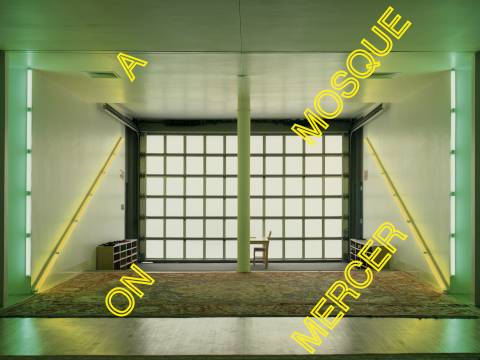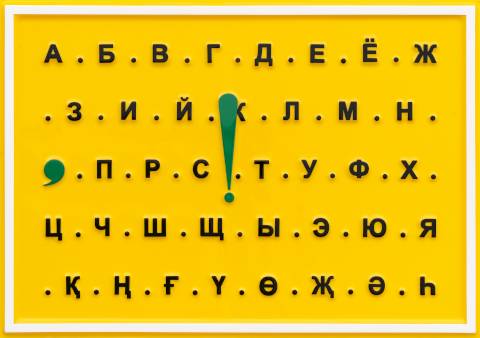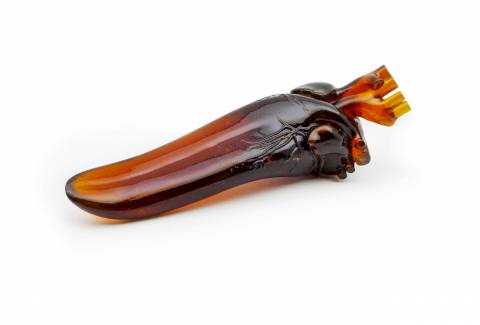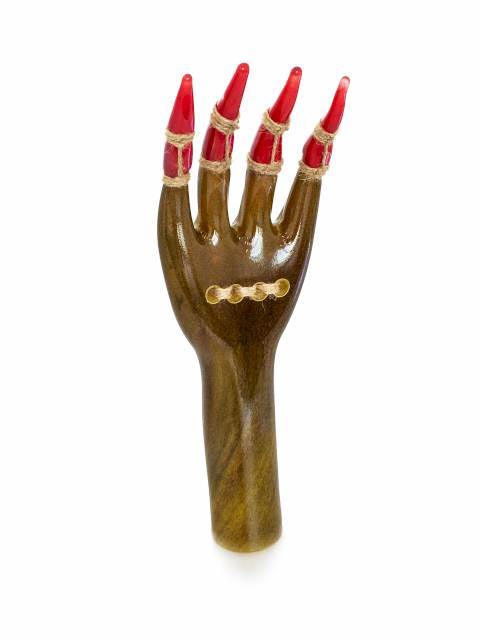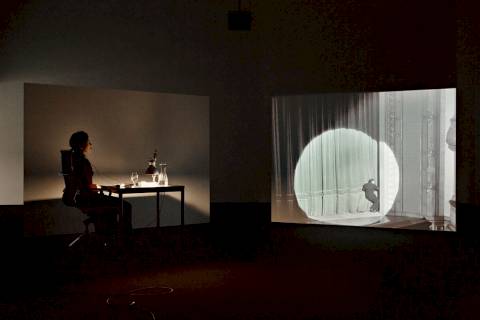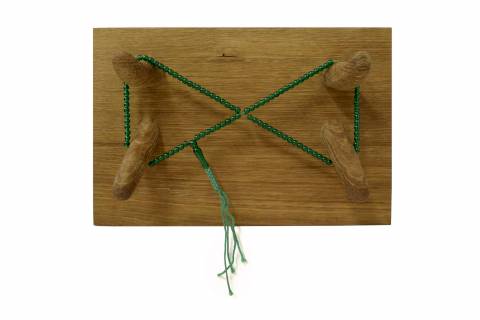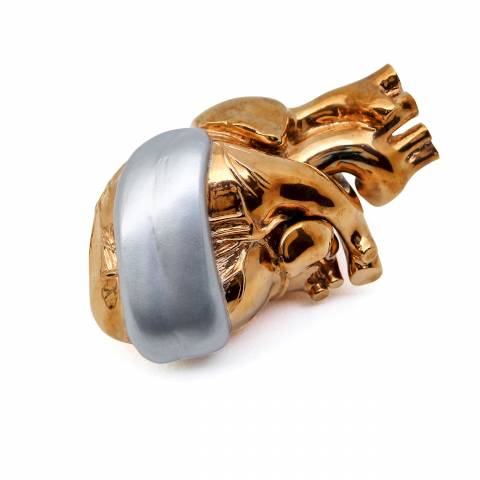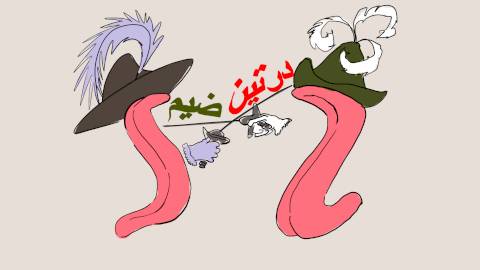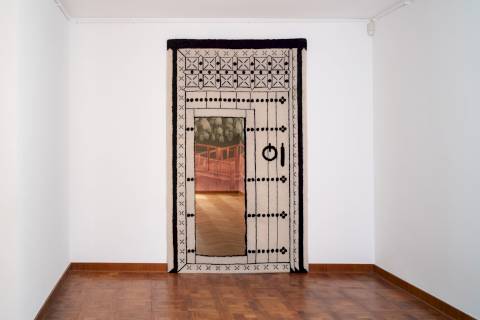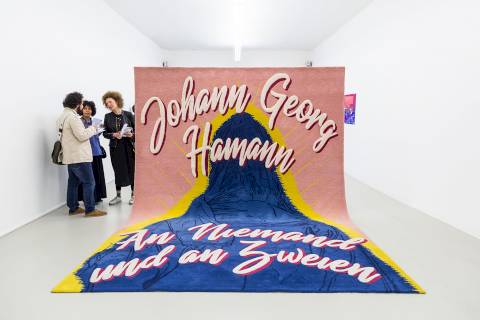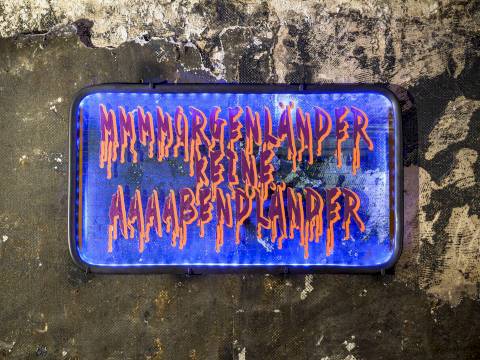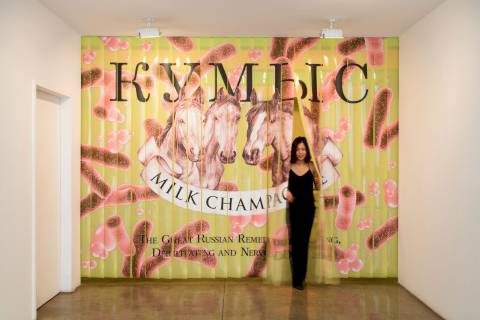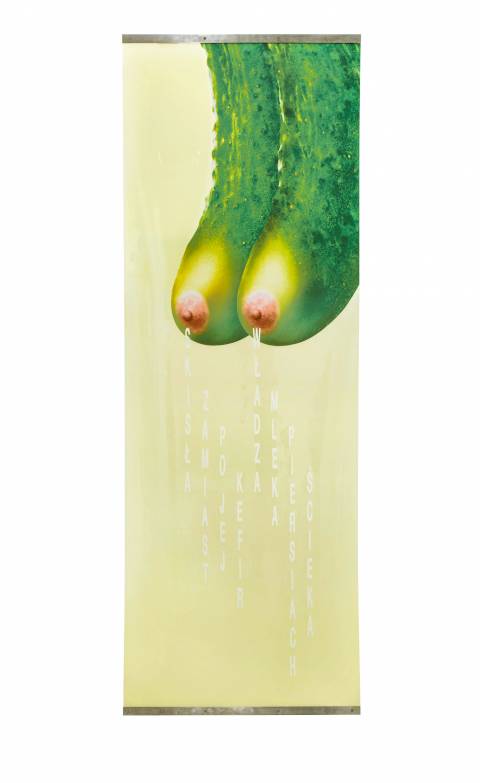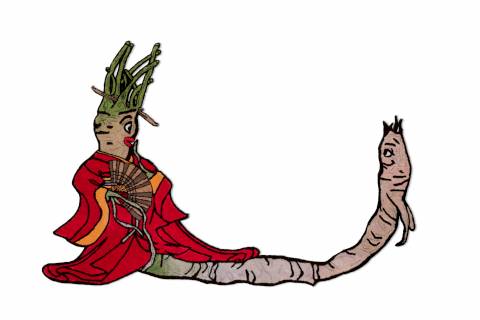The cycle Régions d’être spans the unwieldy geographical remit of Slavs and Tatars – between the former Berlin Wall and the Great Wall of China – while also serving as a prequel to the collective’s practice. Régions d’être is the collective’s term for an area that falls between the cracks of history and general knowledge: largely Muslim but not the Middle East, largely Russian speaking but not Russia, and having a complex relationship with the nation. Yet rather than representing a specific value, history or culture, this ‘region of being’ is as much an imagined, poetic geography as it is a real, political and historical geopolitics.

Azbuka Strikes Back

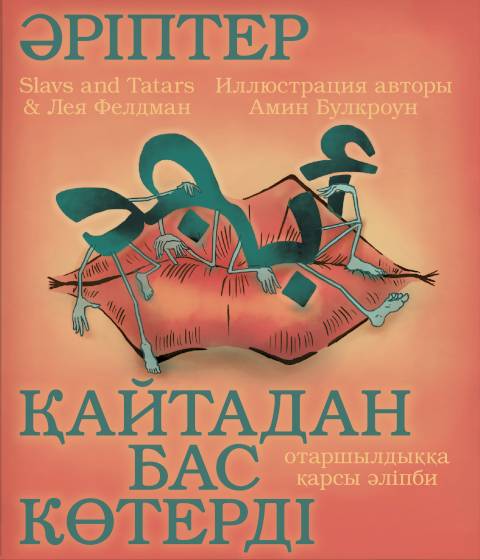
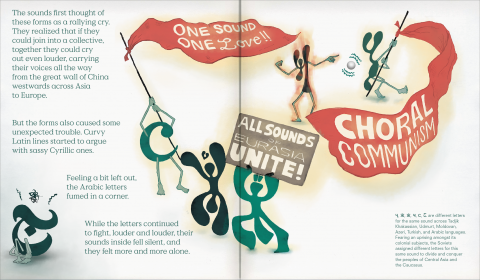

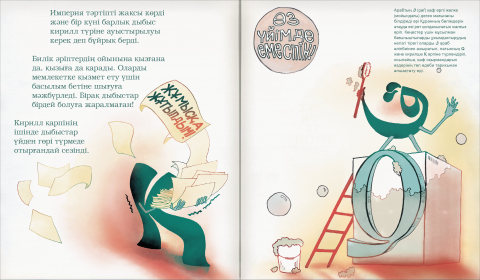
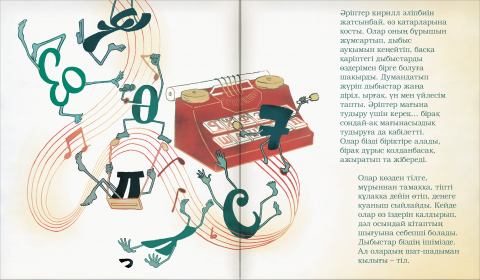
A mordant look at the constantly changing alphabets of 25 million people in the time of the Soviet Union. This interactive book offers a whirlwind tour of ABCs and anticolonialism in the former Soviet sphere.
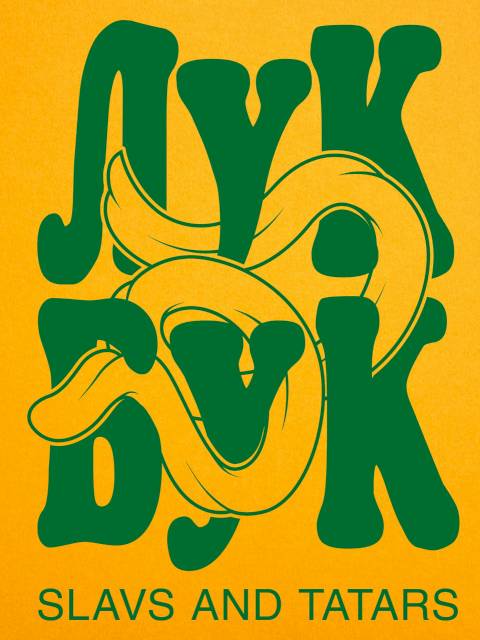
Лук Бук (Look Book)

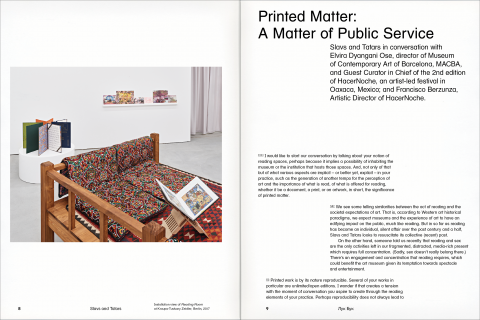
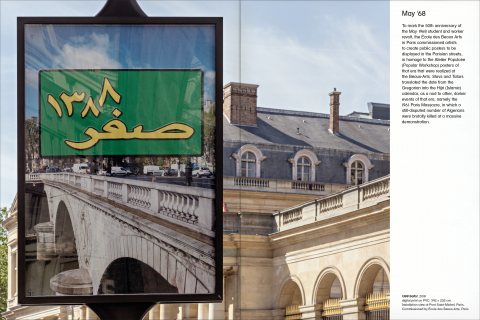

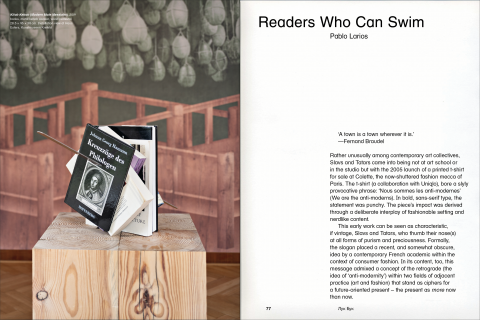
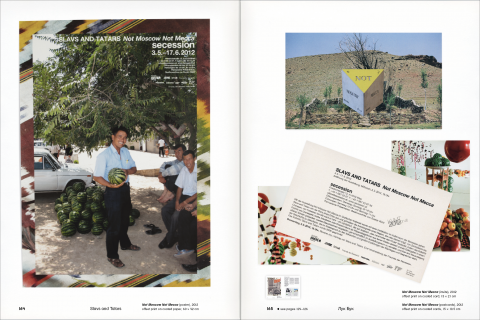
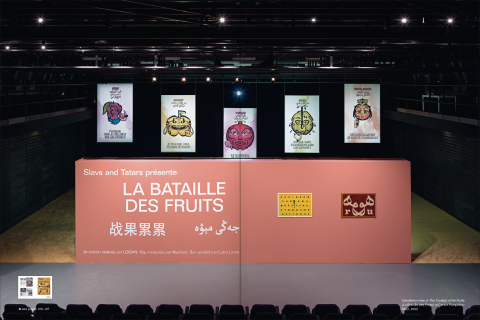
Published on the occasion of the exhibition, Лук Бук offers a comprehensive overview of Slavs and Tatars’ printed matter. Featuring essays by Pablo Larios and Dina Akhmadeeva, the catalogue demonstrates print’s unique ability to convey the conjunction of scholarly analysis, humor, and generosity of spirit that has become a trademark of the collective’s output.
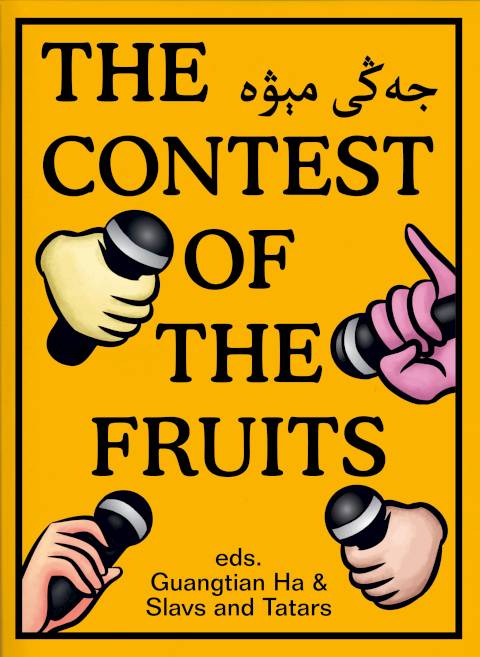
The Contest of the Fruits

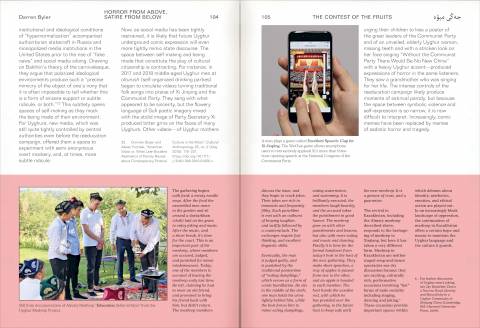
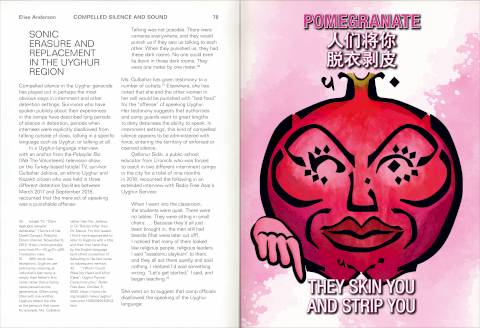
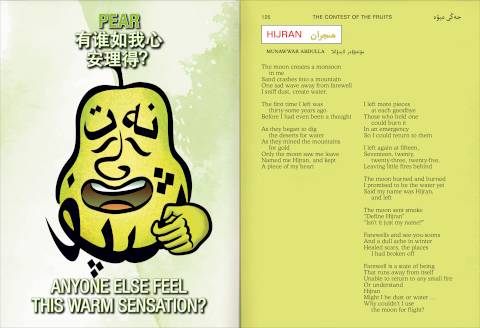
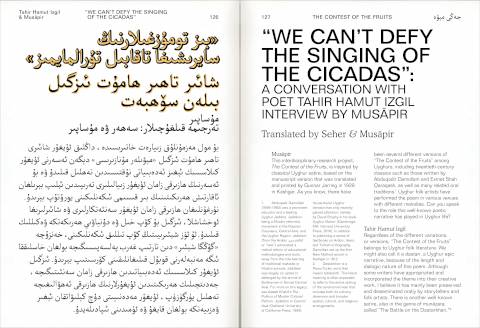
Co-published by MIT Press and Haverford College on the occasion of The Contest of the Fruits animation, the publication features essays by leading scholars and journalists that cover topics ranging from Uyghur script changes to rap in China, from silence to satire. Other contributions take a more tentacular approach: with a selection of poetry by diaspora Uyghur poets and insight on Chinese Muslim calligraphy, maintaining cultural heritage, the Sufi practice of Samā', mäshräp, and pop music.
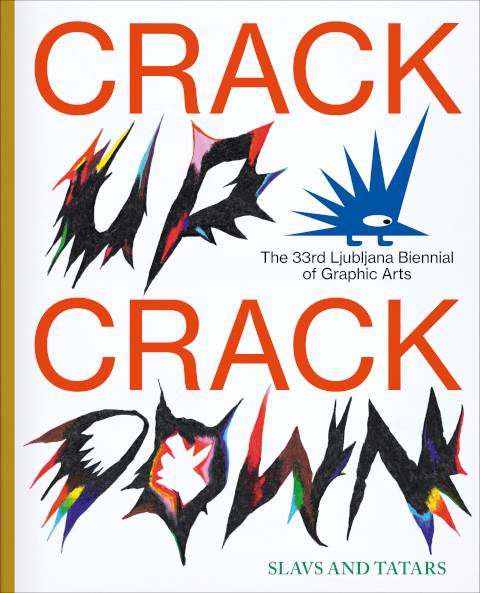
Crack Up – Crack Down





Edited by Slavs and Tatars and M. Constantine. Texts by Hamja Ahsan, Emily Apter, M. Constantine, David Crowley, Arthur Fournier & Raphael König, Augustin Maurs, Metahaven, Alenka Pirman & KULA, Mohammad Salemy, Vid Simoniti, Slavs and Tatars, Goran Vojnović.
As the accessibility of print brought about a proliferation of satirical periodicals in the early 20th century (Slovenia’s Pavliha, Germany’s Simplicissimus, the UK’s Punch, France’s l’Assiette au Beurre, or the Caucasus’ Molla Nasreddin to name a few), so too has the current digital age provided a particularly fertile avenue for satire, one which is fundamentally graphic, be it the meme or the protest poster. Though each enjoys a distinct history, both the graphic arts and satire claim to speak for and to the people.
Designed by Stan de Natris (Slavs and Tatars), illustrated by Nejc Prah, and published on the occasion of the 33rd edition of the Ljubljana Biennial of Graphic Arts, Crack Up – Crack Down considers “the graphic” heritage of the Biennial not as a medium, per se, but rather as an agency and strategy. Purporting to speak truth to power, satire has proven itself to be a petri dish in a world of post-truth bacteria. Edited by Slavs and Tatars, the exhibition’s curators, Crack Up – Crack Down extends the discursive focus of the Biennial on graphics and satire: featuring commissioned essays from Emily Apter on the micropolitics of memes, David Crowley on punk as a platform of dissimulation in Poland and Hungary, Vid Simoniti on the cult Bosnian satire Top lista nadrealista, among other Balkan precedents, and Melissa Constantine on the affective infrastructures of satire with visual contributions and essays by Metahaven, Hamja Ahsan, Alenka Pirman, and others.
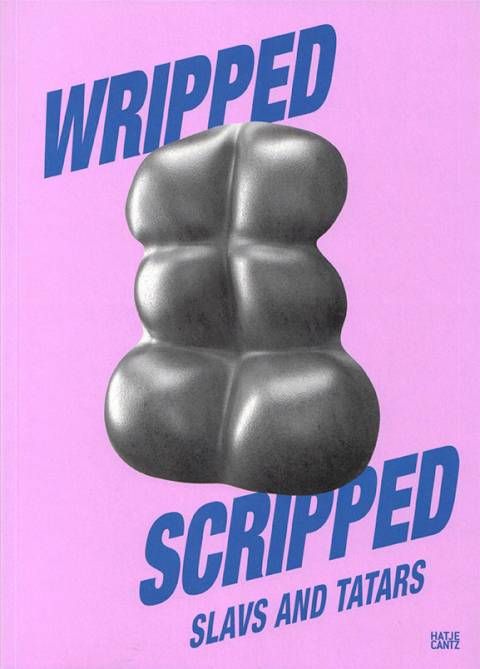
Wripped Scripped

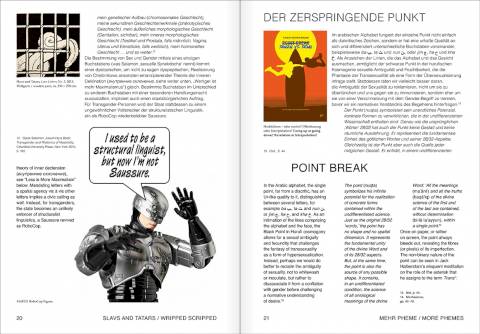
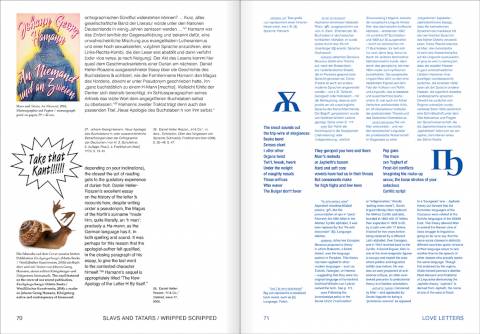
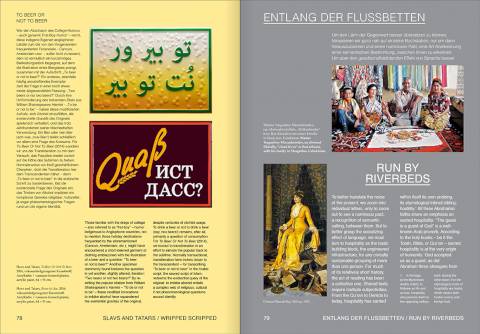
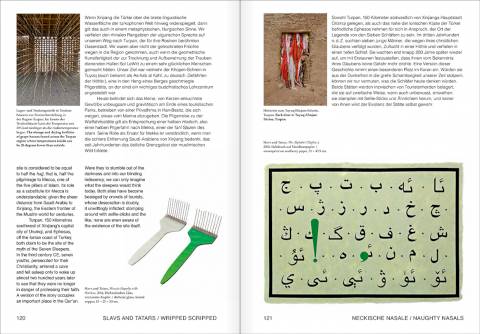
Wripped Scripped continues Slavs and Tatars’ investigation of alphabets as an equally political and affective platform. The book includes an essay on gender fluidity in Hurufism, a 14th century Muslim science of letters as well as Germany’s relationship with Islam and Orientalism through the tetragraph [dsch].
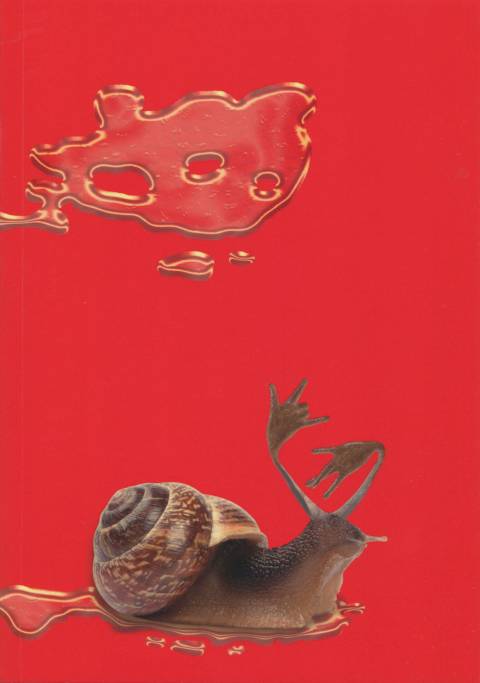
Kirchgängerbanger

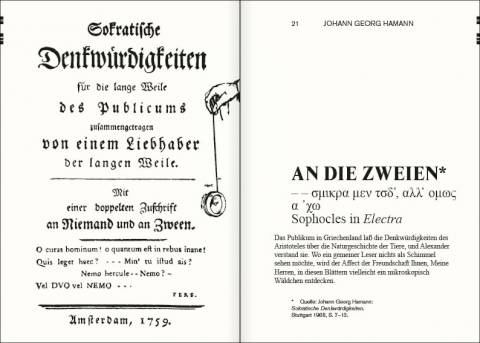
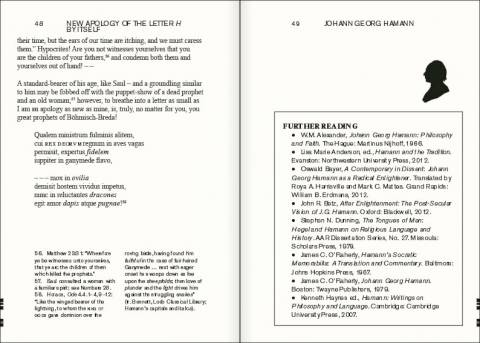

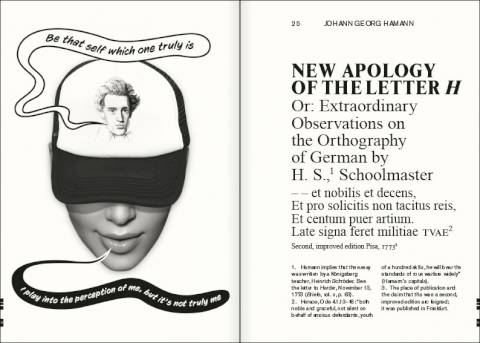
Kirchgängerbanger is a reader on Johann Georg Hamann, the 18th century polemicist, frenemy of Kant, and proto-Postmodernist who critiqued the Enlightenment with an unlikely mix of Lutheran theology and vulgar sexuality, enough to make even Bataille blush: “My coarse imagination has never been able to conceive of the creative spirit without genitalia.” With an introduction by Slavs and Tatars and a selection of essays by J.G. Hamann including the triple-platinum hits ‘New apology of the Letter H’ and ‘New Apology of the Letter H by Itself.’

Slavs and Tatars (Mouth To Mouth)


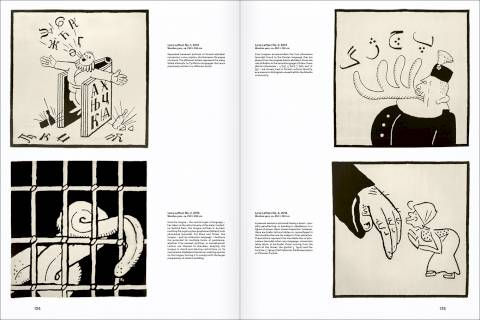
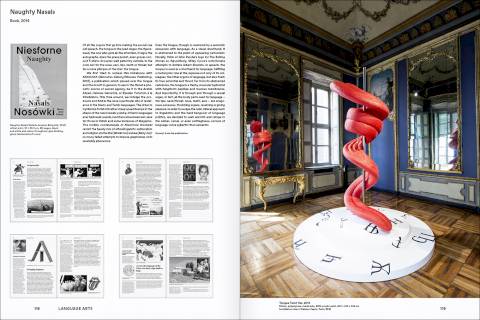
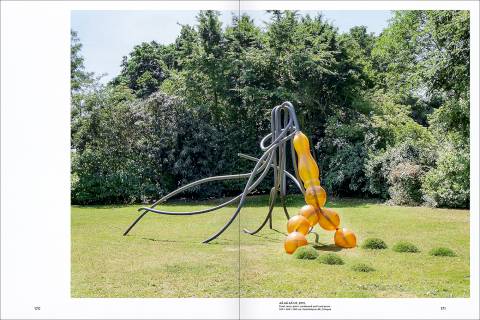
On the occasion of a mid-career survey presented in Warsaw, Tehran, Istanbul and Vilnius, Mouth to Mouth is the first monograph on the collective, with documentation of all eight cycles of work. This monograph offers a critical inventory of Slavs and Tatars’ lecture-performances, exhibitions and publications across ten years of activity. Edited by Pablo Larios with essays by Susan Babaie, Jörg Haiser, and David Joselit.

Mirrors for Princes

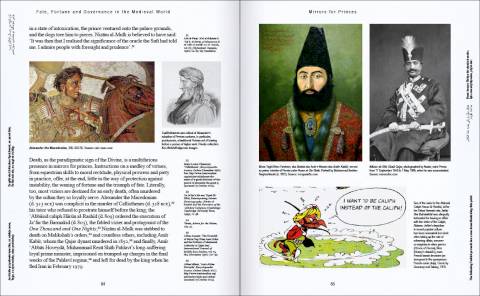
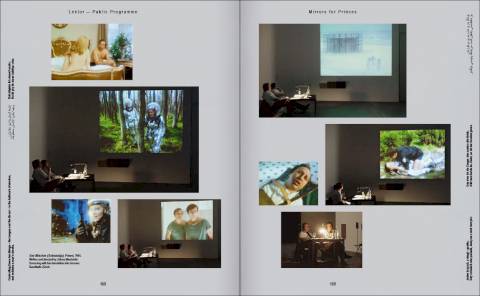

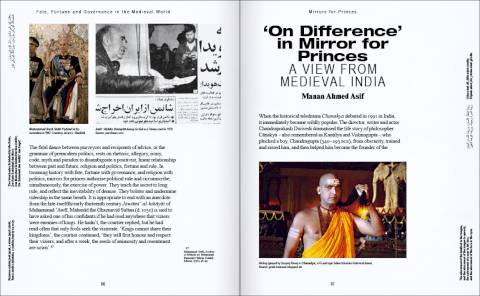
A form of political writing often called advice literature shared by Christian and Muslim lands, during the Middle Ages, mirrors for princes attempted to elevate statecraft (dawla) to the same level as faith/religion (din). These guides for future rulers – Machiavelli’s The Prince being a widely-known if later example – addressed the delicate balance between seclusion and society, spirit and state, echoes of which we continue to find in the US, Europe and the Middle East several centuries later.
Mirrors for Princes brings together the writing of pre-eminent scholars and commentators using the genre of medieval advice literature as a starting point to discuss contemporary politics in Turkey, Indian television dramas, fate, fortune and governance, and advice for female nobility.
The volume includes illustrated essays by David Crowley, Manan Ahmed, Anna della Subin, Neguin Yavari and Lloyd Ridgeon, and an interview with Slavs and Tatars by Anthony Downey and Beatrix Ruf.

Naughty Nasals

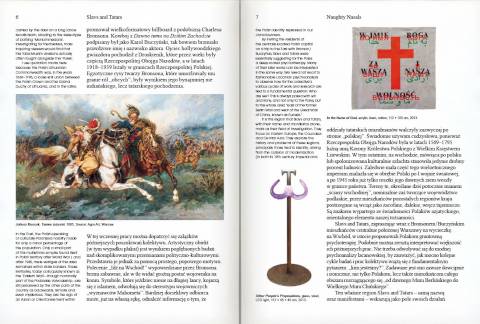
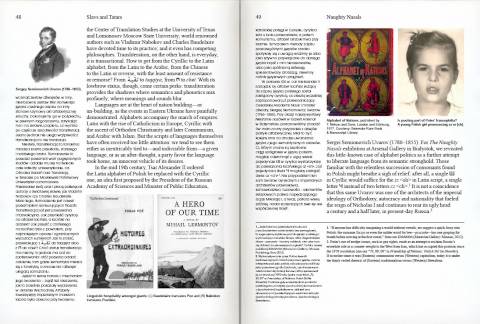

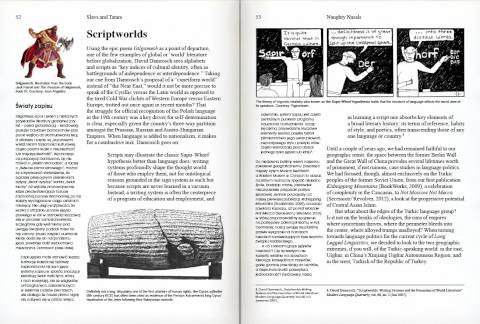
“All the body parts used for language – the lips, neck/throat, nose, teeth, ears – are erogenous, sensuous, throbbing organs, receiving or giving pleasure. In order to escape the cold, clinical approach to linguistics and the hard hangover of language politics, we decided to seek warmth and refuge in the darker, carnal, or even cartilaginous, corners of language: more sybaritic than semantic.
We first tried to redress this imbalance with Khhhhhhh, a publication which passed over the tongue and the mouth in general, to see in the throat a phonetic source of sacred agency, be it in the Arabic Abjad, Hebrew Gematria, or Russian Futurism à la Khlebnikov. This time around, we indulge the proboscis and find in the nose a particular site of resistance in the Slavic and Turkic languages. The drive to Cyrillicize Polish hit rather steep speed bumps in the shape of the nasal vowels ą and ę. If Slavic languages ever had nasal sounds, most have since been lost, save for those in Polish and some instances of Bulgarian. […]”
Excerpt from the publication

Friendship of Nations

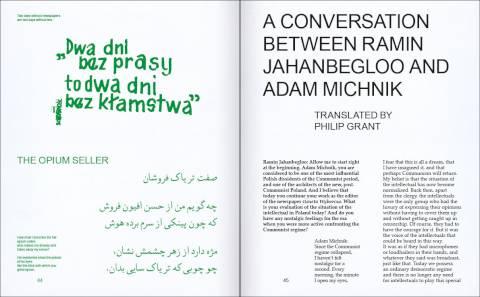
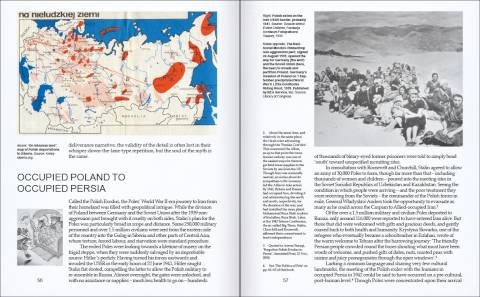
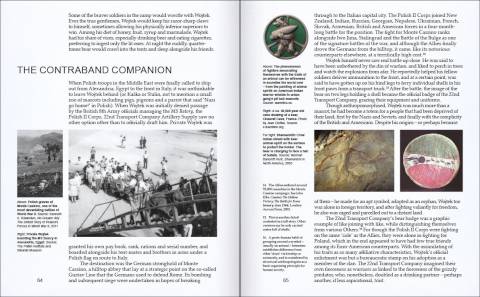
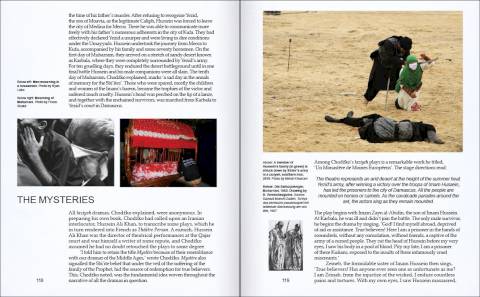
Beginning as an investigation into the apparently disparate events that bookend the twentieth and twenty-first century – the collapse of Communism in 1989 and the Iranian Revolution of 1979 – Friendship of Nations: Polish Shi’ite Showbiz traces unlikely points of convergence in Iran and Poland’s economic, social political religious and cultural histories. Drawing on Slavs and Tatars’ multi-disciplinary practice encompassing research, installations, lecture-performances, and print media this publication embraces new contributions in the form of essays interviews and archival presentation on subjects that range from seventeenth-century Sarmatism to the twenty-first-century Green Movement taking in along the way tales of the Polish Exodus, Wojtek the bear, craft, hospitality, Passion plays and taziyeh, and the political lessons of a Polish slow burn revolution for contemporary Iran. The volume includes essays by Agata Araszkiewicz, Mara Goldwyn, Shiva Balaghi and Michael D. Kennedy, Slavs and Tatars and an interview between Ramin Jahanbegloo and Adam Michnik.

Khhhhhhh


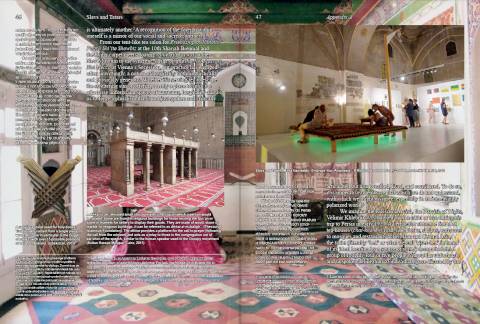
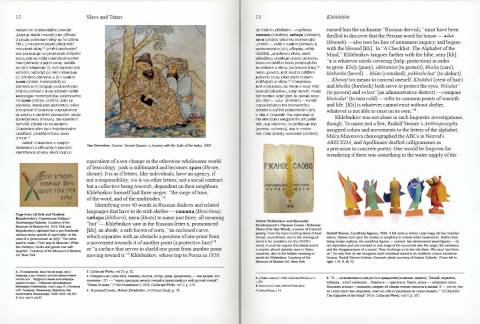
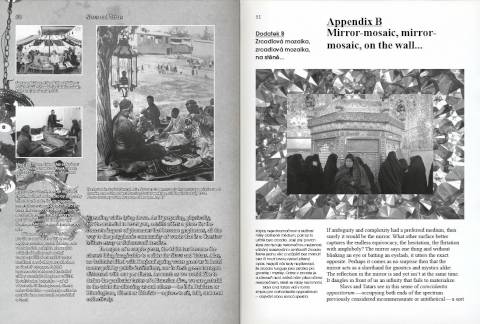
“[Kh] goes by different names – sometimes x, other times ח or ﺥ, and on lesser known occasions, қ – but manages to put forth a common front on the numinous potential of language and wisdom. Our Khhhhhhh investigates the archetypal patterns of the aforementioned, quasi-homophonic letters, and what their corresponding grapheme, sound, or root have to say about the sacred role of language in a world beholden to a secular rage to know it all. Despite being tugged in different directions by the Semitic, Cyrillic, Turkic, and Arabic alphabets, Khhhhhhh pours the first drops of concrete into new foundations before becoming the brick thrown at the increasingly delicate edifice of the present. […]”
Excerpt from the publication

Not Moscow, Not Mecca

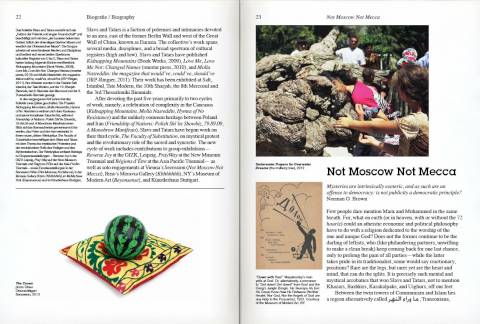

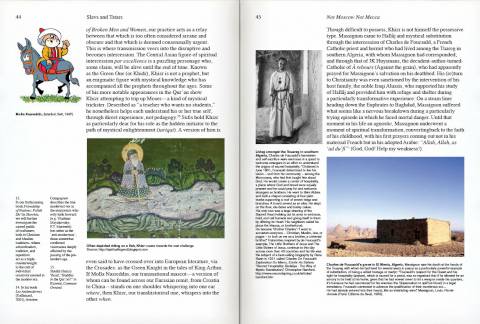

“Few people dare mention Marx and Mohammed in the same breath. For, what on earth (or in heaven, with or sans the 72 houris) could an atheistic economic and political philosophy have to do with a religion dedicated to the worship of the one and unique God? Does the former not continue to be the darling of leftists, who (like philandering partners, unwilling to make a clean break) keep coming back for one last chance, only to prolong the pain of all parties – while the latter takes pride in its traditionalist, some would say reactionary positions on a range of issues? Rare are the legs, but rarer yet are the heart and mind that can do splits. It is precisely such mental and mystical acrobatics that sweep us as Slavs and Tatars, not to mention Khazars, Bashkirs, Karakalpaks, and Uighurs, off our feet. […]’
Between the twin towers of communism and Islam lies a region alternatively called Ma wâra al nahr, Transoxiana, Greater Khorasan, Turkestan, or simply Central Asia. Like us, it too belongs to too many peoples and places at once, caught between Imperial Russia and Statist China, Chinggisid and Sharia laws, sedentary and nomadic tribes, Turkic, Persian, and Russian languages – not to mention Arabic, Latin, and Cyrillic alphabets. As Maria Elisabeth Louw writes, ‘[t]he stubborn enchantedness of the world is perhaps most telling in the parts of the world where the concrete efforts to disenchant it were extraordinarily organized and profound.’ We turn to this ‘country beyond the river’ (Amu Darya, aka the Oxus) in an effort to research the potential for progressive agency in Islam. In a land considered historically instrumental in the development of the faith, but nonetheless marginalized in our oft-amnesiac era, its approach to pedagogy, to the sacred, and to modernity itself offers a much-needed model of critical thinking and commensurate being.”
Excerpt from the publication

Molla Nasreddin

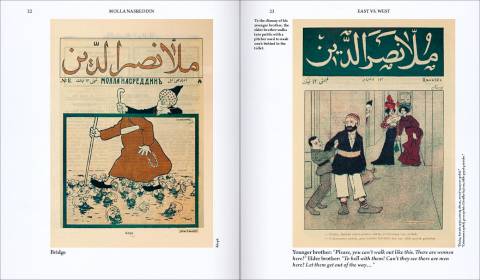

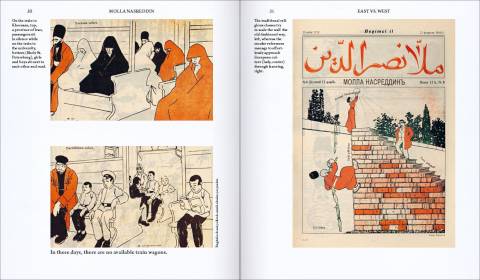
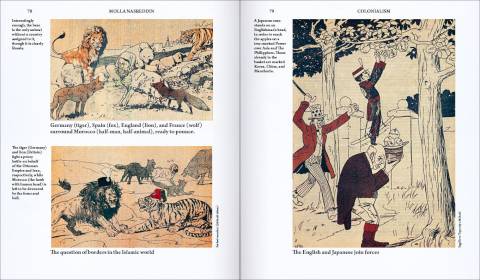

Published between 1906 and 1930, Molla Nasreddin was a satirical Azeri periodical edited by Jalil Mammadguluzadeh (1866–1932), and named after the legendary Sufi wise man-cum-fool of the Middle Ages. Thanks to its prominent use of caricatures, the weekly was arguably one of the most important 20th century periodicals of the Muslim world, read from Morocco to India. With an acerbic sense of humour and compelling, realist illustrations reminiscent of a Caucasian Honoré Daumier or František Kupka, Molla Nasreddin attacked the hypocrisy of the Muslim clergy, the colonial policies of the US and European nations towards the rest of the world, and the venal corruption of the local elite while arguing repeatedly and convincingly for Westernization, educational reform, and equal rights for women.

79.89.09

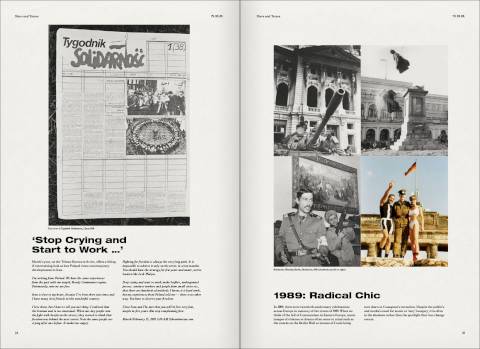
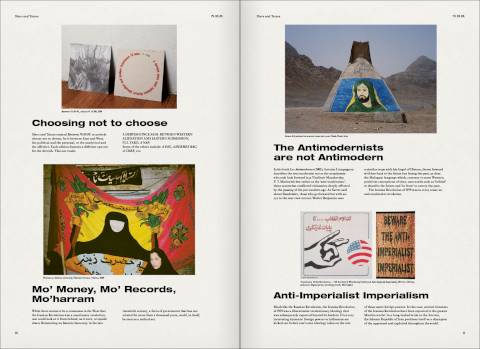
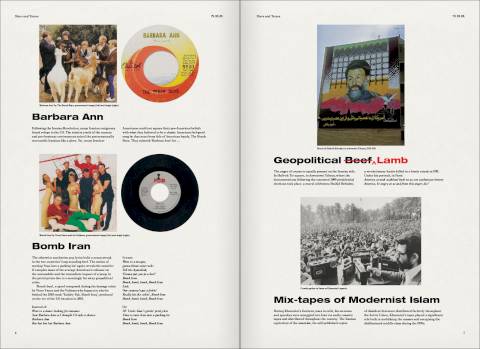
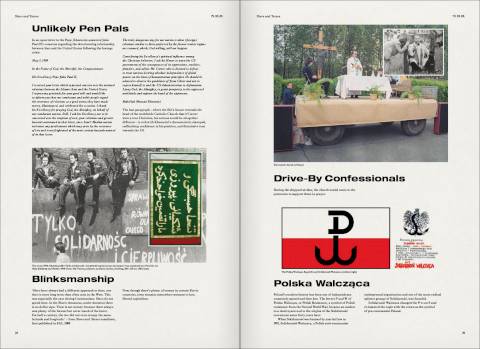
A transcript of Slavs and Tatars’ first lecture-performance, 79.89.09 revisits the book-ends of twentieth-century Communism and twenty-first century Islam, reimagining Polish/Iranian solidarity and exploring new lessons of the revolutions of 1979 and 1989.

Love Me, Love Me Not


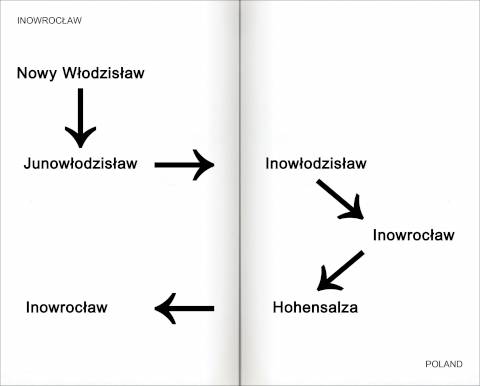
A selection of 150 cities within Slavs and Tatars’ Eurasian remit, Love Me, Love Me Not: Changed Names plucks the petals off the past to reveal an impossible thorny stem: a lineage of names changed by the course of the region’s grueling history. Some cities divulge a resolutely Asian or Muslim heritage, so often forgotten in some citizens’ quest, at all costs, for a European, Christian identity. Others vacillate almost painfully, and others with numbing repetition, entire metropolises caught like children in the spiteful back and forth of a custody battle. Love Me, Love Me Not celebrates the multilingual, carnivalesque complexity readily eclipsed today by nationalist struggles for simplicity and permanence. If, from the foggy perch of the early 21st century, we tend to see cities like living organisms that are born, grow and even die, why should their names be any different?

Kidnapping Mountains


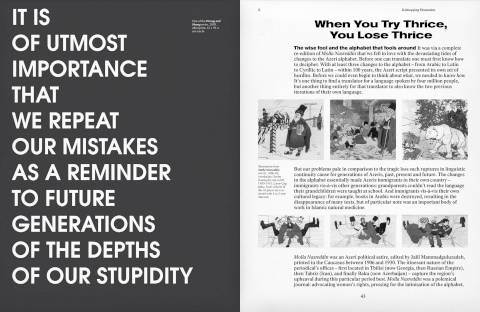

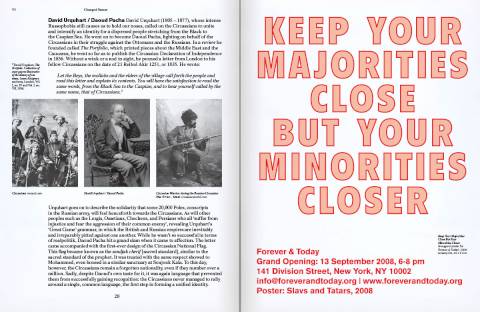
Kidnapping Mountains is a playful and informative exploration of the muscular stories, wills, and defeat inhabiting the Caucasus region. Comprising two parts: an eponymous section addressing the complexity of languages and identities on the fault line of Eurasia, and ‘Steppe by Steppe’, a restoration of the region's seemingly reactionary approaches to romance.

Live Streaming

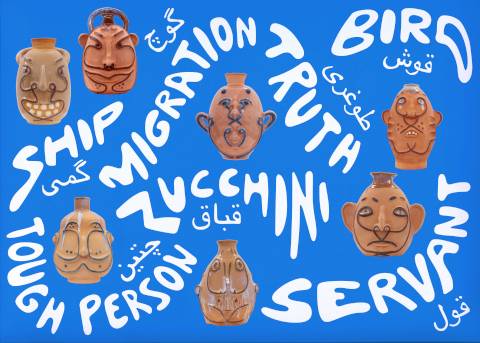
False Friends


Self-Help

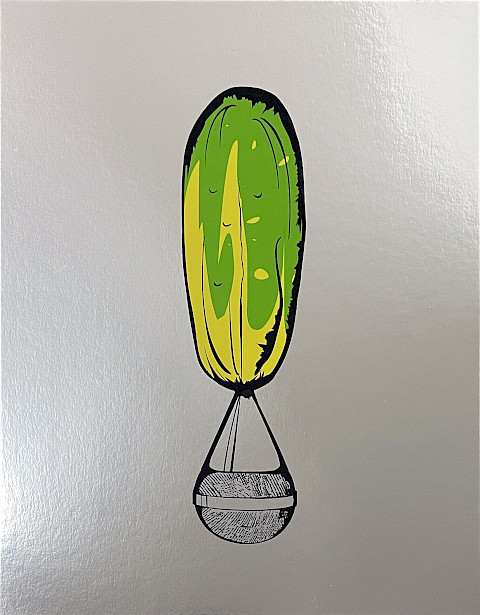
Open Mic

Via its prolific use as a shorthand for satire, humor and comedy, here the gherkin becomes a verb, an imperative, in the shape of an exclamation mark.

Sinophrys Salon

On the occasion of Pinakothek's acquisition and presentation of Hi, Brow! an edition celebrating the often-overlooked hairs in between our brows.

Figa

An obscene hand gesture specific to Turkic and Slavic cultures, Figa revisits the old Egyptian proverb: “Life is like a cucumber: one day in your hand and one day in your ass.”
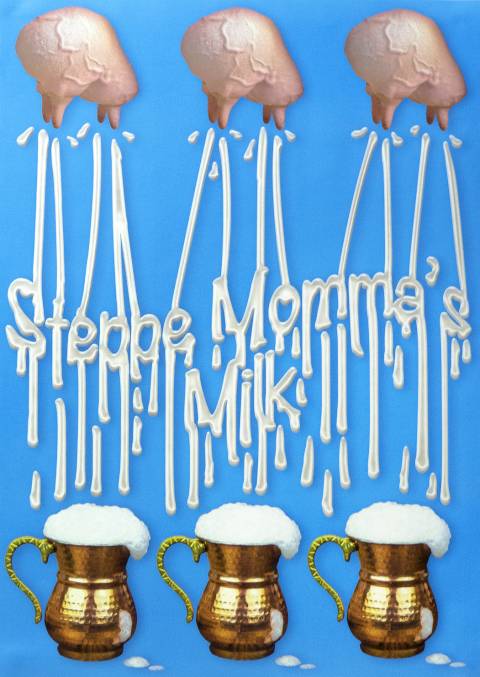
Steppe Momma’s Milk


An Niemand / an Zweien

J.G. Hamann’s famous dedication – To Nobody and to Two – is an invitation to think beyond the binaries of Enlightenment thinking.
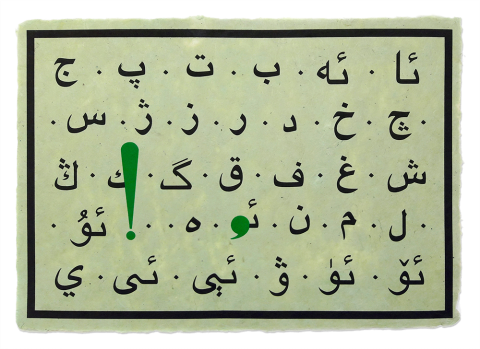
The Alphabet (Uighur)


Bicephalic

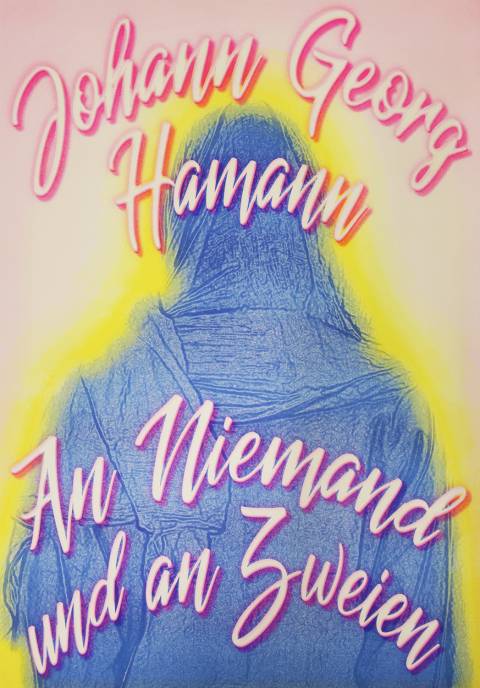
An Niemand

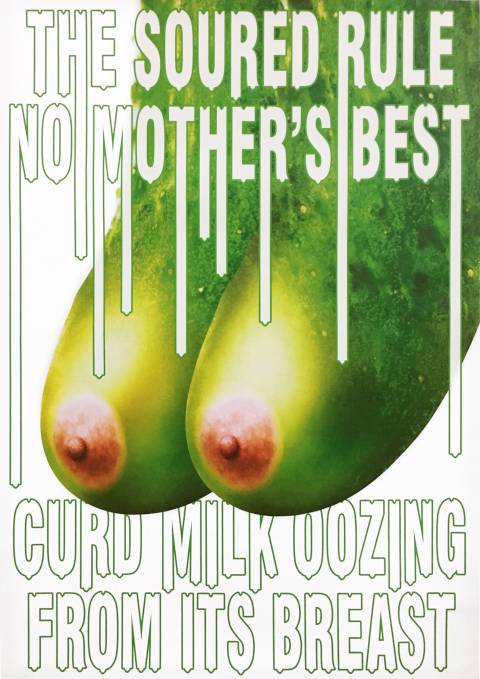
Pickle Tits

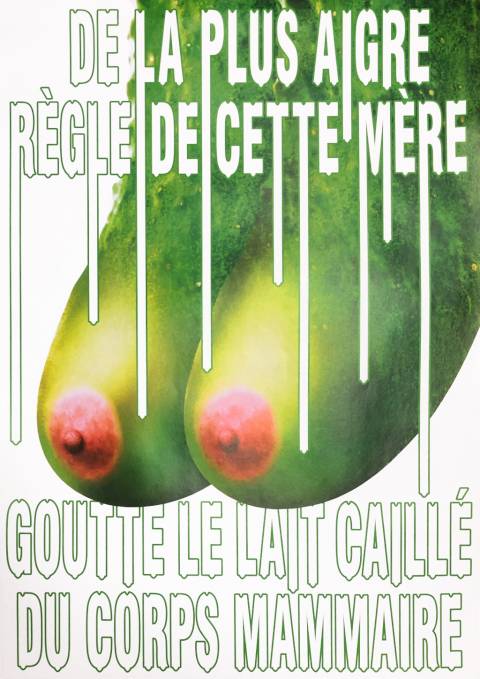
Beyond gustatory pleasure and digestive benefits, fermentation also offers an affective if ambiguous means to understand the rotting of our current social contract. The phenomenon of fermentation is at once destruction (decay), activation (probiotics), and transmogrification (a cucumber into a pickle). Instead of the nourishment often associated with patriarchal or matriarchal states, here the milk has soured to kefir tits.

Qabaret

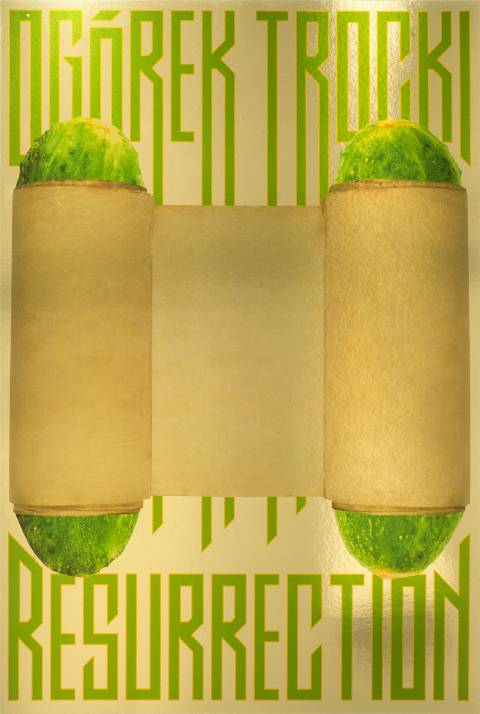
Ogórek Trocki

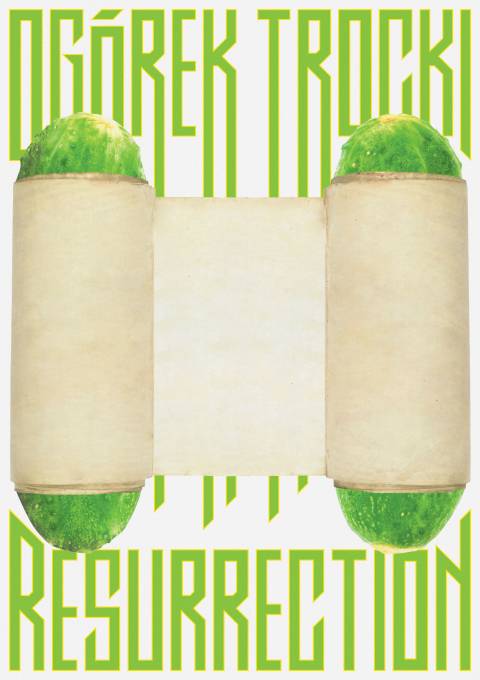
The Trakai cucumber, famed for its high sugar content, hails from the city of the same name in Lithuania. The specimen was brought to the Baltic countries and Poland by Crimean Karaites, an anti-rabbinical sect of Turkic-speaking Jews who first settled in the area in the late fourteenth century. Having spent more than a millennium living amongst majority Muslim populations, the Karaites have a remarkably syncretic if strict approach to faith: one finds basins for ablution outside their kenessas or synagogues; shoes must be removed before entering a place of prayer; the faith is passed on via patrilineal descent and not matrilineal as other Jews. During Islam’s golden age, between the 9th and 11th centuries, Karaites made up roughly 20-30% of the Jewish population. In the Crimea, though, Karaites had a particularly malleable approach to their own history. In the 19th century, Abraham Firkovich, a Crimean Karaite leader, convinced the tsar that they had settled in the area before the lifetime of Jesus Christ and thus were not responsible for his death. In 1863, the word ‘Jew’ was officially removed from documents belonging to members of Karaite community, sparing them taxes levied on Jews in Imperial Russia as well granting them the right to live outside the Pale, and thus avoid the regular pogroms. During the Nazi occupation of Crimea, Seraya Shapshal, the Karaite leader, convinced the Nazis that they were ethnic Turks, descendants of the Khazars, and thus they were spared the Holocaust. Though the Crimean Karaites survived two major persecutions of the nineteenth and twentieth centuries, sadly, the cucumber they were renowned for cultivating did not.

Larry Nixed, Trachea Trixed

Larry Nixed, Trachea Trixed looks at various attempts to Cyrillicize sounds or phonemes that did not previously exist in the Russian Cyrillic alphabet, one of many attempts to extend or embed Soviet influence, with a decidedly more sensuous, if not sexualized, approach to the traditionally cold, clinical approach of linguistics.

The Wizard of Öz Türkçe


In the Name Of God

An unofficial motto ‘W imię Boga za Naszą i Waszą Wolność’ (In the Name of God, For Your Freedom and Ours) has been appropriated by peoples all around the world in their struggles for self-determination. Featuring both Russian and Polish in its original iteration, the banner is a complex nod to the fate binding two countries whose history has been contentious to say the least. By translating the original into Persian and re-instating the Russian, W Imię Boga addresses the transnational, if not transcendental, nature of this phrase, aiming to rescue it from the jaws of parochial or imperial instrumentalizations.

Behind Reason

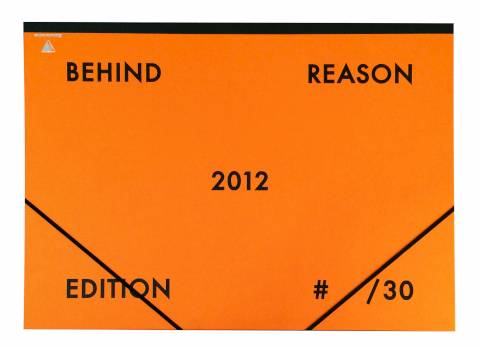
A series of prints on the overlooked story of mysticism within modernity, made to accompany Beyonsense, Slavs and Tatars’ Projects 98 exhibition at the Museum of Modern Art in New York.

Between 79.89.09

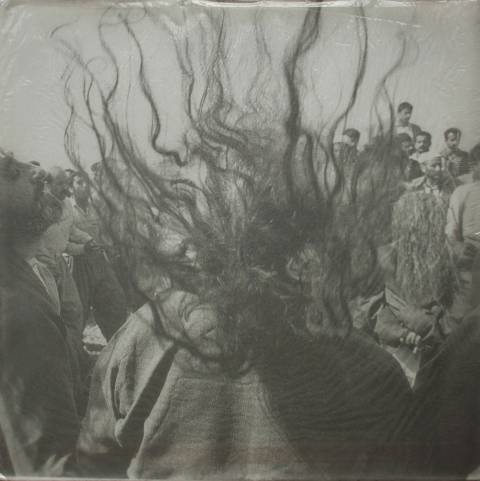

AaaaaaahhhhZERI!!!

During the editing process of Molla Nasreddin, we had a difficult time identifying a translator who could read all three iterations – Arabic, Latin and Cyrillic – of Azerbaijani and translate into English. AaaaaaahhhhZERI!!! is as much a scream for help as a tribute to the 20th century script changes of the alphabet. The poster speaks to the legacy of such language politics on the cultural heritage of Azerbaijan, effectively making different generations immigrants within their own language.

Steppe by steppe romantics


“By their very nature secret practices, being secret, are generally hard to comment on. Still, we can imagine that the institution of secret marriage must be at least as old as that of the public one, possibly older, in fact, if one is to imagine the birth of ‘coupledom’ as taking place between two people alone under the cover of night. Secret marriage today remains an incalculable part of the institution – and perhaps one of its most romantic forms. […]
As though to compensate, we celebrate the secret ceremony – gay, straight or non-binary – not with equal but greater fervour. Just as a stolen glance is more arousing, a forbidden tryst more urgent, so too is the secret marriage more alive, more keen. Marry in secret in solidarity, in lust, out of an exhaustive need. Marry in secret and do with the heart what the gun cannot: melt the frozen conflicts, be they in Abkhazia or in Glendale.”
Excerpt from the publication
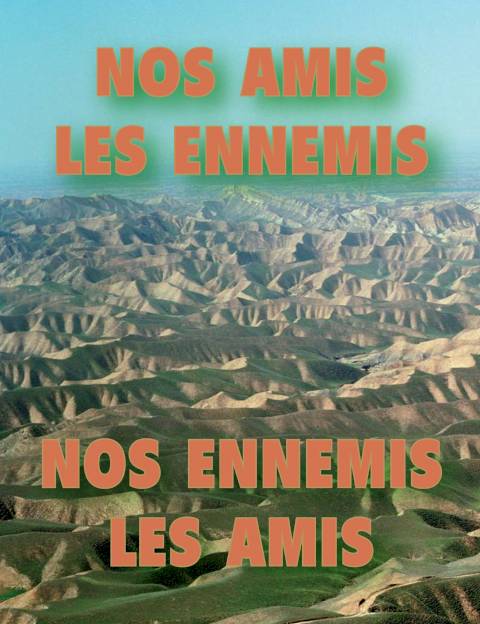
League of Impatience

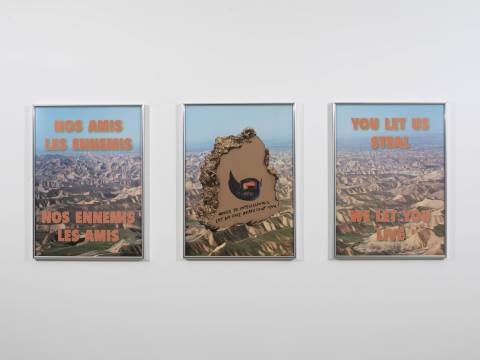

Last of the Eurasianists

As with many thorny ideas, Lev Gumilev’s Eurasianism has been hijacked, hacked, vulgarized. What was a critique of the Enlightenment underpinnings of Russia’s pivot to the West under Peter has today sadly become a shorthand for Russian nationalism. In that vein, to misquote Bono: “Charles Manson Alexander Dugin stole this song from The Beatles Lev Gumilev, we’re stealing it back.”
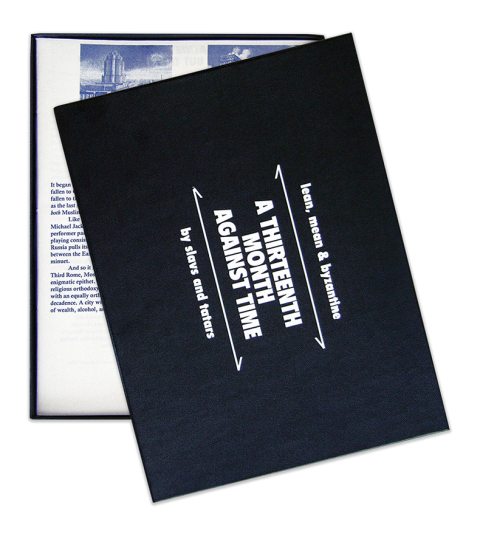
A Thirteenth Month Against Time


A libretto of daily polemics, reflections, and musings on the very defeatist approach to time so dear to S&T, A Thirteenth Month Against Time runs thirty-two days (or pages) in length and acts as an addendum to one’s everyday calendar or diary.
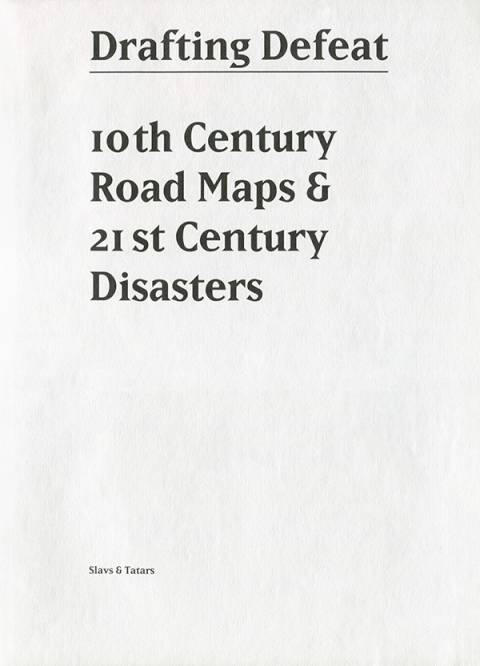
Drafting Defeat


We have always had an aesthetic weakness for the merciless and brutal banality of bureaucracy. Little did we know that such a weakness would extend to the bureaucrats themselves. The following are reproductions of 10th century maps – including Egypt, the Caspian, Iraq, amongst other places – by Al-Istakhri (aka Ibn Khordadbeh or Al Farsi) found in a 1933 Soviet edition of Nasser Khosrow’s Safarnameh, or Book of Travels. Both Istakhri and Khosrow were Persian bureaucrats whose legacy was a paper trail of the very antithesis of administration: a regime of curiosity that attempted to describe and map out the Middle East as a coherent geographic and cultural region. Khosrow, an 11th-century Persian poet and philosopher, had led an uneventful life as a tax collector in present day Turkmenistan when one night, in his sleep, a voice told him to leave behind his life of worldly pleasures. Khosrow dropped his avowed weakness for the medieval Merlot and began immediately to plan a seven-year trip through the Caucasus and the Caspian to the holy cities of Medina and Mecca. Khosrow was, to some extent, the millenary Muslim equivalent of a 21st-century born-again Christian. Except where the former asked questions, the latter offers only solutions. Where the former travelled extensively, the other is unlikely to have a passport.
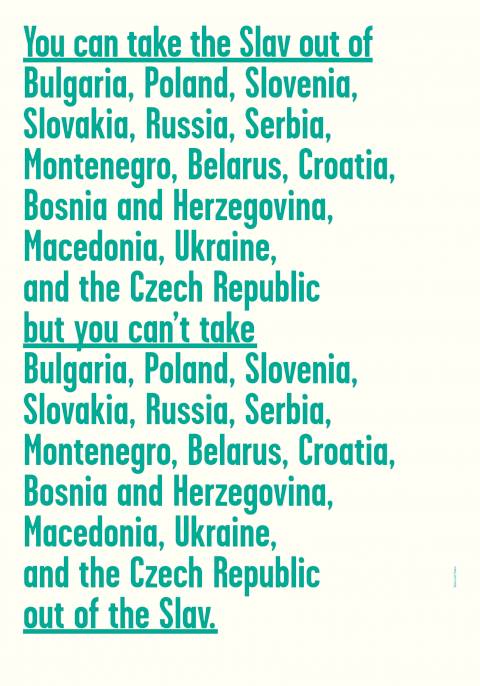
Slavs

The closest thing we have to a manifesto.
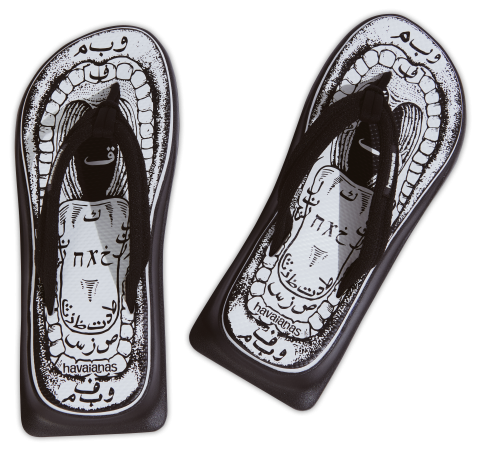
Mother Tongues and Father Throats

Limited to 50 units worldwide, Slavs and Tatars illustrated Havaianas’ signature Tradi Zori flip-flop. The design implemented on the footwear revolves around the ‘Mother Tongues and Father Throats’ artwork, created in reference to the throat being a source of mystical language.

Hi Brow!

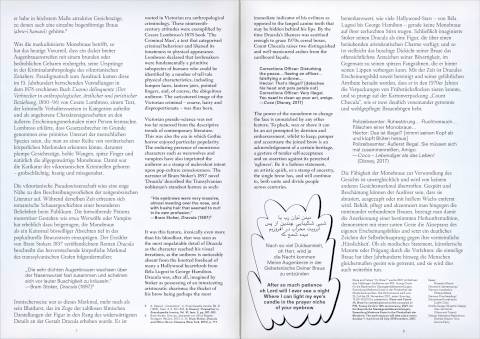
Featuring an essay by Natasha Morris on the history of the monobrow, this fold-out poster was presented at the Pinakothek der Modern in 2021 to accompany the sculpture-performance of the same name.
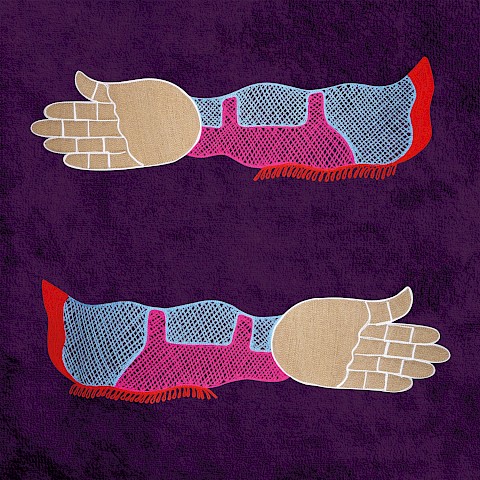
Ritme Jaavdanegi

Album artwork for Mohammad Reza Mortazavi, a percussionist known for playing traditional Persian instruments such as the tombak and daf.
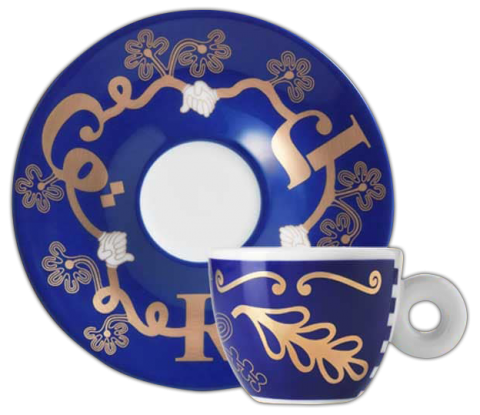
The Dark One

For the illy Art Collection, Slavs and Tatars present The Dark One, a homage to the geographic origins of coffee through a phonetic game. Three letters from three different alphabets almost magically reproduce the same guttural sound: “qaf”, the first letter of the original word for coffee in East Africa and the Arabian peninsula. The letters alternate to celebrate language and sensuality in a design that brings together geopolitics, food, & art.
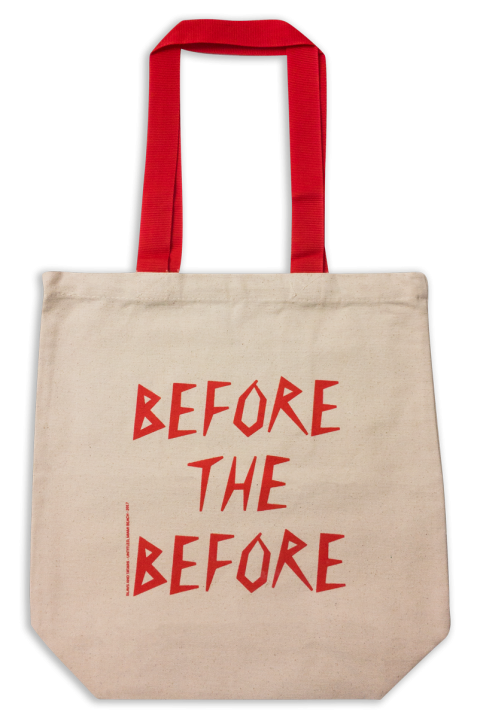
Before the Before

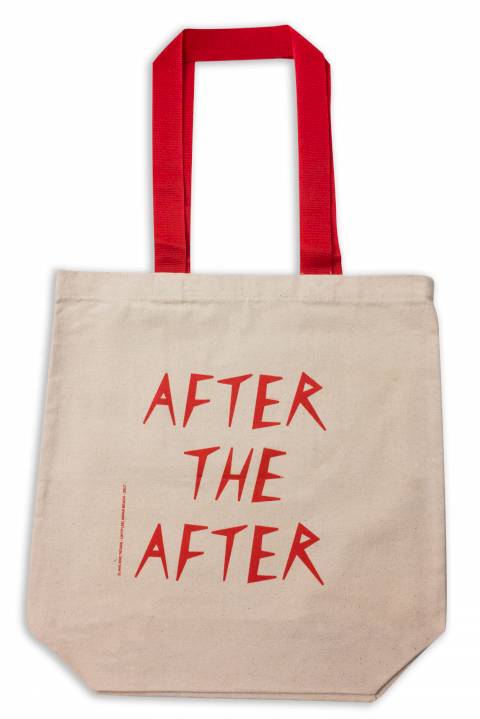
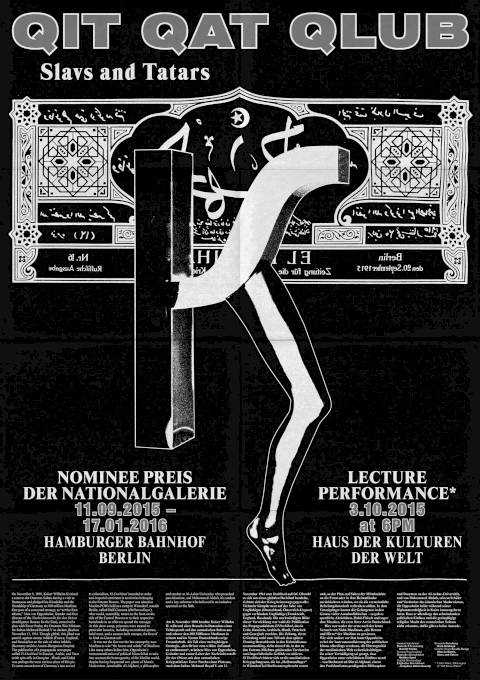
Qit Qat Qlub

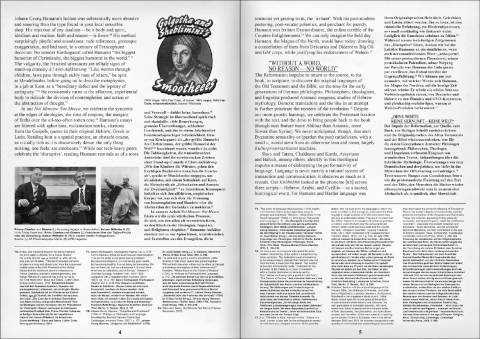
Conceived for the Preis der Nationalgalerie 2015 exhibition at the Hamburger Bahnhof, a fold-out bilingual essay (English/German) and poster attempting to rescue German philology and its less than stellar secular origins.
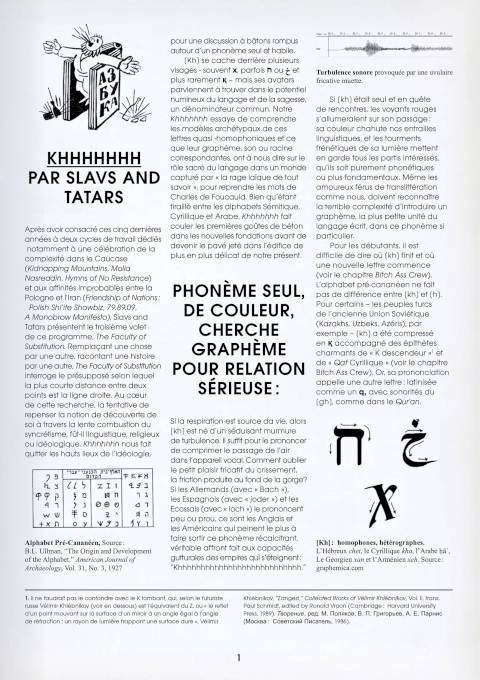
Khhhhhhh (posters)



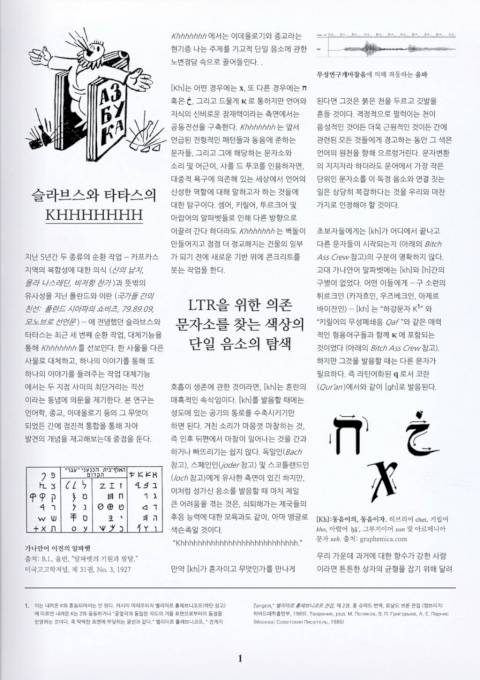
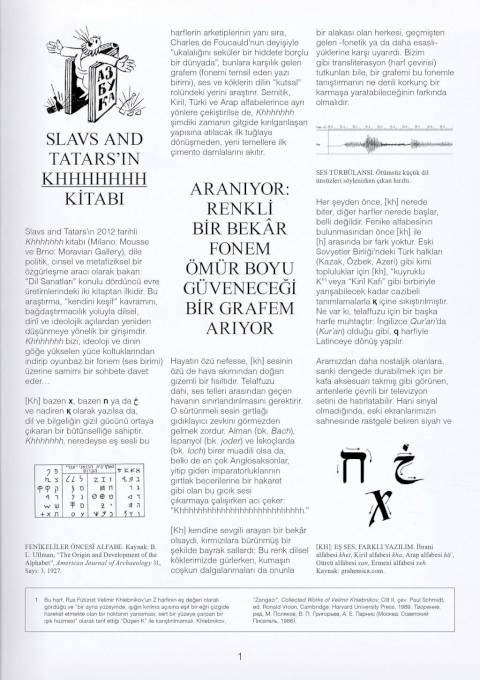

French: Printed on the occasion of Un Nouveau Festival at the Centre Pompidou in 2013.
Greek: Printed on the occasion of Long Legged Linguistics, a solo exhibition at the Art Space Pythagorion, Samos in 2013.
German: Printed on the occasion of Open House at the Kunstverein Braunschweig in 2015.
Korean: Printed on the occasion of The Voice at Coreana Museum of Art, Seoul in 2017.
Turkish: Printed on the occasion of Mouth to Mouth, Slavs and Tatars’ mid-career survey at SALT Galata, Istanbul in 2017.
Arabic: Printed on the occasion of Muʿawiya’s Thread at 32Bis, Tunis in 2023.

Nous Sommes Les Anti-Modernes

In Les Antimodernes, his study of 19th and 20th century French literary figures, Antoine Compagnon takes a contrarian approach to defining what makes a modernist. Instead of our highly processed diet of futurist heroes (think F.T. Marinetti or Vladimir Mayakovsky), who believed that science, speed, and industry would deliver us from our evil, backward ways, Compagnon offers a refreshing dose of the rear- or arrière-guard. The true modernist, he claims, has a conflicted relationship with the passing of the pre-modern era: s/he moves towards the future but keeps a watchful eye on the past. Examples include Joseph de Maistre, the Counter-Enlightenment philosopher who argued to reinstate the monarchy in the years following the French revolution; Charles Péguy, a poet and essayist whom both anti-Vichy and pro-Vichy camps claimed for themselves; and Baudelaire, whom Sartre described as driving into the future with an eye on the rearview mirror.
Our very languages betray us, at least the Indo-European ones. Along with the pox they brought the plague of positivism: be it French, Russian, Persian, or Polish. Our words describe the future as ahead of us, implying we can see where we are going. And the past is described as behind us, and thus somehow invisible or irrelevant. Thank God for the Malagasy, who seem to have got it right, for they describe the past as in front of us: taloha or teo aloha, and the future as behind us, aoriana or any aoriana.




























